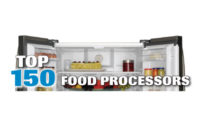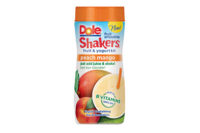When it comes to what consumers want, it’s a never-ending battle. One day, they want sweet potato fries, the next, they want them with added spices. Then, they want them shaped a certain way or bagged in a particular format. Thankfully the folks at McCain Foods’ Plover, Wis., facility are no stranger to change.
Case in point—the Plover plant recently underwent a $34 million renovation, which included state-of-the-art technology designed to increase throughput, quality and efficiency. Today, the 500,000-square-foot plant is the most diverse facility in the McCain Foods network, says Mark Schmaus, plant manager for the Plover facility.
“[The Plover facility] is more complex, more viable and now plays an integral part in McCain Foods’ strategic planning process,” says Schmaus. “[The Plover facility] can do things that the other facilities can’t. Not because they physically can’t, but with nine different processing lines, we have the potential to make a diverse range of products, from A to Z.”
“The markets are competitive and show no signs of resting,” Schmaus adds. “Our customers are growing in size and sophistication, and they require suppliers who can keep up with them. I am extremely proud of the change readiness skills of our employees and their responsiveness to answering customers’ demands in today’s tough business environment. Our entire Plover bench is very acclimated to adverse operating conditions and sudden twists and turns in the marketplace. Plover will satisfy its customers with innovative technology with superior quality, value and service, which means we will lead the way with better product solutions. One day, our operating plan calls for one thing, the next day, things have changed and the marketplace or customer is calling for a different solution. It’s what we do.” That’s why the Lisle, Ill.-based company was named Refrigerated & Frozen Foods’ 2012 Frozen Foods Processor of the Year.
From the ground up
In 1997, McCain Foods purchased the former Ore-Ida plant from H.J. Heinz Co., along with the Burley, Idaho; Appleton, Wis.; Grand Island, Neb.; and Fort Atkinson, Wis., sites.
Then, just last year, the Plover facility underwent an extensive expansion, adding close to 100,000 square feet of robotic palletizing, packing and belt blanchers, all designed to “increase our throughput, our quality and our efficiency for our Prime 2 line,” says Schmaus.
In addition to nine different processing lines, the Plover plant is home to 32 packaging lines, operates 24 hours a day in 12-hour shifts and pumps out roughly 2 million pounds, or 409 SKUs, of sweet potato products, such as tater tots, crispers, crowns, hash browns, potato shells, mashed potatoes and battered French fries for both retail and foodservice channels.
The facility also holds a battery of certifications, including AIB Gold, BRC (British Retail Consortium) and Circle U Kosher, plus an ISO 14001 rating and Energy Star certification for two consecutive years.
Other noteworthy achievements include its thermal heat recovery projects, which helped the Plover plant make a 20% reduction in energy over the last five years.
“I have a desire to do my part and include those around me to preserve our earth. Our plant vision continually calls on us to improve and protect our natural resources. For example, we’ve had a year-over-year reduction in water of 25%,” Schmaus adds.
The Plover plant also features a plant hazard team and learning education programs for allergy, good manufacturer practices and a safety behavioral observation feedback process. McCain Foods is also home to McCain University, an online e-learning center for its employees.
From old paradigm to new paradigm
When it comes to putting their money where their mouth is, the folks involved with the $34 million investment made sure every penny counted.
“I believe in safety and quality, and quality and safety,” says Joe Henriksen, area manager, processing for the Plover site.
That’s why the 100,000-square-foot addition transformed what was considered an “old school” plant into one that exemplifies efficiency, automation and quality.
For starters, the blanching room now encompasses a state-of-the-art belt blanching system that allows for on-the-fly setup changes and efficient process adjustment for the seasonality of a potato.
The Plover plant also boasts an automated palletizing system, complete with nine robotic palletizers, which together, can run up to 18 different SKUs at one time. Logistically speaking, the new automated palletizers maximize truck space, enabling McCain Foods to stack pallets 90 inches high as opposed to the 51-55 inches high they previously stacked, Henriksen says.
“Our old palletizer could only go four or five cases high,” he adds. “What you’ll see here is we can go nine or 10 cases high. We call that truck height. With the new robotic palletizer, we can run everything as close to that 102-inch [truck height] mark as possible, while maximizing outbound shipping efficiencies throughout the delivery process, minimizing carbon emissions and strengthening Plover’s supply chain solutions.”
In light of the plant’s extreme makeover, the Plover facility represents McCain Foods’ largest processors of sweet potato products. In fact, 70% of the site’s raw material, including white potatoes, comes from nearly 35 growers within a 60-mile radius.
At the time of Refrigerated & Frozen Foods’ visit, the Plover plant was running Prime 2, the sweet potato fry line. (Primes 1, 2 and 3 produce tater tots, hash browns and patties).
From farm to fork
To start, roughly 60 loads, or 3 million pounds, of potatoes enter the plant each day from one of McCain Foods’ 12 climate-controlled storage cellars. Potatoes are received directly from the field or storage and rigorously tested, then are flushed with water to remove excess dirt, rocks and plant material.
“Because sweet potatoes float and whites don’t, we have to lift the vine chain out of the water to prevent them from climbing out over the top,” says Henriksen. “When running white potatoes, [the vine chain] is submerged into the top of the water and the vines and corn cobs float.”
After they’re washed, large potatoes are separated for use on the French fry production lines, while the smaller ones are removed to use for potato specialties. Then, high-pressure steam loosens the potato skin; remaining skin is removed by automated brush peelers. Defects are cut by hand and discarded.
Next, the potatoes enter the pre-heater, where they are slightly softened by being heated in water. Doing so prevents the French fries from shattering during the cutting process.
Potatoes are then sent through a set of water knives, which cut the fries into pre-determined dimensions. Specialty products are cut using customized equipment that differs from the basic water gun. Defects are electronically removed from the fries through a system that detects dark spots. Once defects are recognized, a series of knives remove the defective area(s).
Then, freshly cut strips pass over a series of screen and shaker graders to remove smaller pieces. The longer strips move on to become Premium Length or Extra Long fries, while the smaller pieces are once again removed and used for potato specialty products.
Now, the fries enter the newly updated blanching room, where a warm water blanch deactivates enzymes that cause discoloration and removes excess sugars that result in uneven browning. The fries then run through sodium phosphate (SAPP), which further protects against graying of the fry and adds consistent, desired color.
Afterward, fries convey into the drying chambers, which are pressurized to force warm air through the product bed. This promotes a crisp external texture with less oil absorption. Then, the strips travel into the fryer, where they remain for 30-120 seconds at 360-380°F.
After the fryer, the strips are cooled prior to freezing to speed up the freezing process, and then are individually quick frozen using cold forced air at 0° to -20°F.
Fries then pass over another series of grader screens that remove short and broken units. Next, another quality control inspection removes any remaining defects.
After undergoing pre-cooling, freezing and length grading, the fries travel through computerized scale systems to ensure accurate net-weight control. Automated packaging equipment help to minimize handling, breakage and temperature abuse, while state-of-the-art metal detection systems ensure that all product is free of metallic manner.
From there, product is transported into to the case packers, then feed up the elevators and convey into the robotic palletizing room. Cases from all nine processing lines feed through one conveyor via a Zipper that connects the conveyors into one. Product feeds down the sort line through the barcode scanner, and then gets placed onto one of nine robotic palletizers, which together, can run up to 18 different SKUs at one time.
After the robots are finished, full pallets are pulled off to get stretch wrapped, and then feed into the third-party refrigerated warehouse where they remain at 0°F until the orders are filled and shipped out.
From top-of-the-line equipment to a slew of consumer-friendly SKUs, McCain Foods’ newly expanded Plover plant has certainly found its niche—yet continues to be no stranger to change.
Fast Facts
Company: McCain Foods
Plant Location: Plover, Wis.
Products: Sweet potato products, including tater tots, crispers, crowns, hash browns, potato shells, mashed potatoes and battered French fries for both retail and foodservice channels.
Total Square Feet: 500,000
Distribution: Global
No. of Employees: 650
No. of Processing Lines: 9
No. of Packaging Lines: 32
No. of SKUs: 409
Produces: 2 million pounds of finished product a day
Certifications: Energy Star, AIB Gold, BRC, Circle U Kosher, ISO 14001









